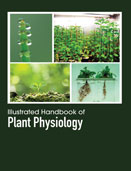Handbooks

The field of plant physiology includes the study of all the internal activities of plants?those chemical and physical processes associated with life as they occur in plants. This includes study at many levels of scale of size and time. Fundamental processes such as hotosynthesis, respiration, plant nutrition, plant hormone functions, tropisms, nastic movements, photoperiodism, photomorphogenesis, circadian rhythms, environmental stress physiology, seed germination, dormancy and stomata function and transpiration, both parts of plant water relations. This book provides that information in a succinct and user-friendly way, what we know about plant physiology, in addition to how that information was gathered.
Plants are eukaryotic, multicellular, non-motile organisms. The plant cell walls are composed of cellulose and are autotrophic. Plants exhibit alteration of generation and have a distinctive diploid and haploid phase. Plant physiology is the study of the vital processes of plants, and has always been focused largely on the higher green terrestrial plants, the autotrophic (self-feeding) plants that feed us animals. In part, plant physiology has roots in agriculture. Plant physiologists study the physical, chemical and biological functions of living plants, right from the whole plant down to the cellular level.
Illustrated Handbook of Plant Physiology provides a broad explanation of the physiology for plants from seed germination to vegetative growth, maturation, and flowering. Plant physiology has vibrant scope in the field of agriculture. It is very important to know the functions of a living organism or any of its parts. They also have scope in agriculture fields, medicine, food production and textiles. The field of plant physiology includes the study of all the internal activities of plants?those chemical and physical processes associated with life as they occur in plants. This includes study at many levels of scale of size and time. At the smallest scale are molecular interactions of photosynthesis and internal diffusion of water, minerals, and nutrients. At the largest scale are the processes of plant development, seasonality, dormancy, and reproductive control. Major subdisciplines of plant physiology include phytochemistry (the study of the biochemistry of plants) and phytopathology (the study of disease in plants). Plant response to physical factors like radiation, temperature, fire, wind, humidity, pH, and soil. Ecophysiology of plants is concerned with mechanisms and integration to variable conditions. Mechanisms of plants like the responses and sensation of plants to environmental changes and their responses to highly variable conditions like high sunlight and shade within tree canopies. If you think hard about it, and review everything above, you will see that plants are at the foundation of just about every human endeavor. This gives us very good reasons to study plants. This Text includes the study of plant response to environmental conditions and their variation. Stress from water loss, changes in air chemistry, or crowding by other plants can lead to changes in the way a plant functions. These changes may be affected by genetic, chemical, and physical factors. This Handbook is intended for researchers, students, and specialists in related fields who wish to gain insight on the concepts and research trends in the fields of Botany, Plant Physiology, Agriculture, Forestry and related fields